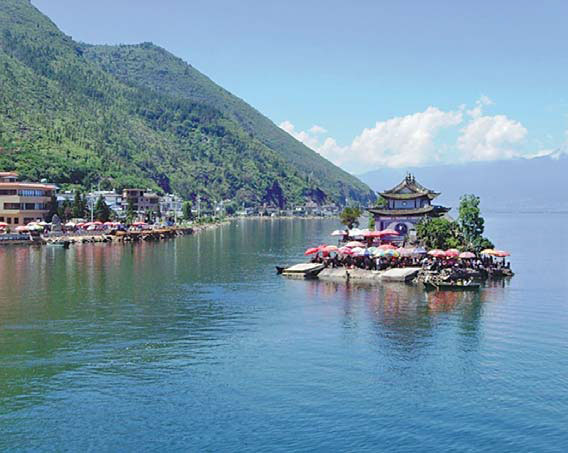Pollution threatens tourist site
The view is breathtaking as I sail aboard a cruise ship with more than a thousand tourists on the 253 square kilometer Erhai Lake in Dali Bai prefecture of Yunnan province.
The beautiful alpine fault lake in Southwest China is a major tourist attraction and a key source of water for the Dali area.
I admire the mountains and the homes around the body of water that help make it truly picturesque.
|
Business is booming in Erhai Lake. Messi Bala / For China Daily |
Yet, the beautiful lake is to some degree a victim of its own success. As tourism has boomed, the area has prospered, and factories and other development have sprung up in the area. The lake has had problems with pollution.
Its waters, famed for being crystal clear, turned milky in some areas due to pollution from nearby development early this year, according to news reports. Residents posted photos online of the problem and local officials vowed action.
On board the ship, it can be easy for passengers to forget about the health of the lake. They find their way to the auditorium, where a group of Chinese women serves three courses of tea.
But tourism also can be a direct cause of pollution.
"Every day, two ships carrying foreign and local tourists do more than five rounds. And each tour lasts at least an hour," says Shan Jianmin, director of the bureau of environmental protection of the Dali Bai autonomous prefecture. "Dirt or garbage gets thrown into the water, consciously or not. These wastes then pollute this lake."
For him, pollution from large-scale tourism is the main danger facing Erhai Lake. In 2013, tourism in the prefecture generated more than 24 billion yuan ($3.9 billion; 3.14 billion euros) from 22.4 million visitors, prefecture officials say. Tourism is topped only by tea production and the marble industry as the main source of revenue for the province.
Erhai Lake is at the heart of tourism attractions in the area, which also include the Buddhist temple of Dali and the old capital of the former Dali Kingdom. The kingdom was established in 937 AD and ruled by 22 kings until 1253, when it was conquered by the Mongols.
Local officials say the volume of tourists has been increasing by as much as 20 percent a year, which helps explain the massive influx of people and industries around the lake, leading to pollution woes.
"More than 400,000 people live in houses around the lake," Shan says. Waste from residences, small shops and factories have an impact. "Monitoring the sewer outlets and waste treatment keeps our office's 80 employees very busy," he says.
In 2005, local officials built a pipeline to stop household sewage from flowing directly into the lake. Workers sample the lake's waters each morning to check water quality. Drainage systems for factories and residential areas are inspected.
Restrictions have been placed on fishing to allow fish to reproduce.
Despite pressure to grow tourism to benefit the economy, the environmental bureau is trying to safeguard the natural wonders that the tourists come to see in the first place. I hope they succeed.
For China Daily



















